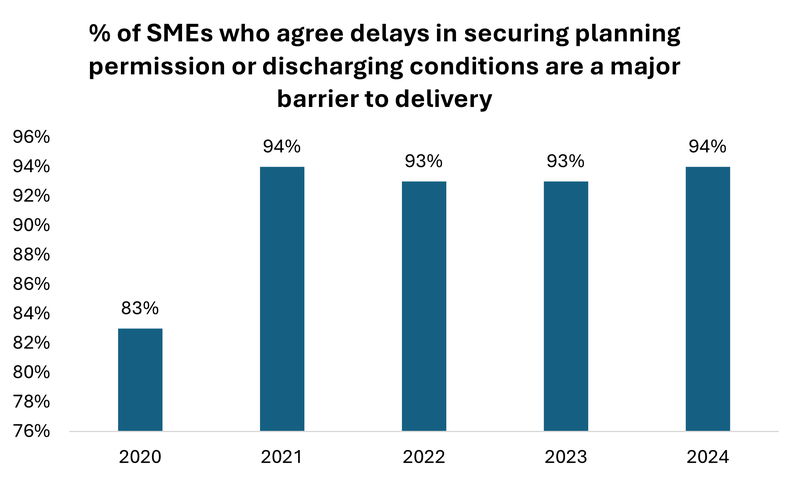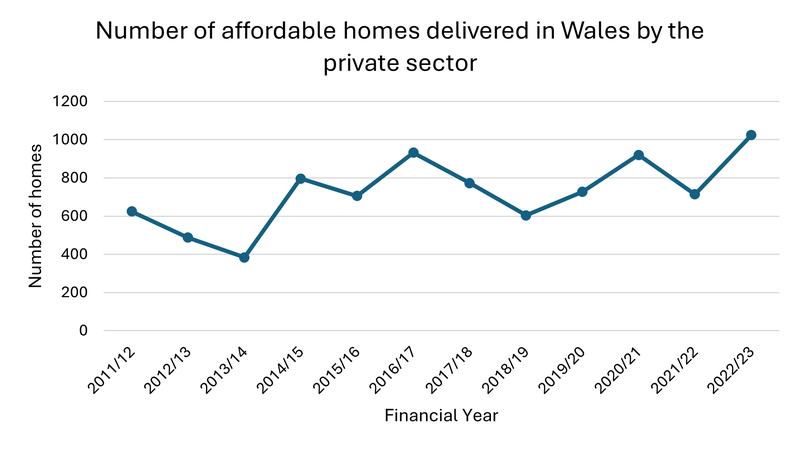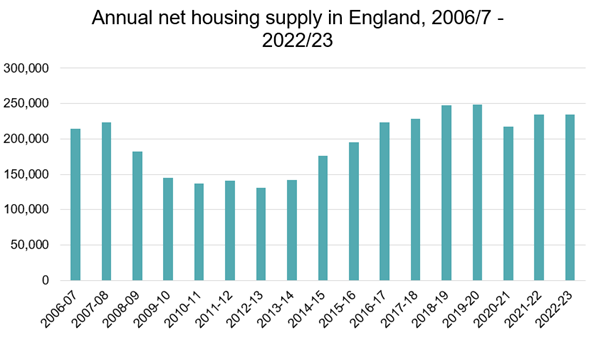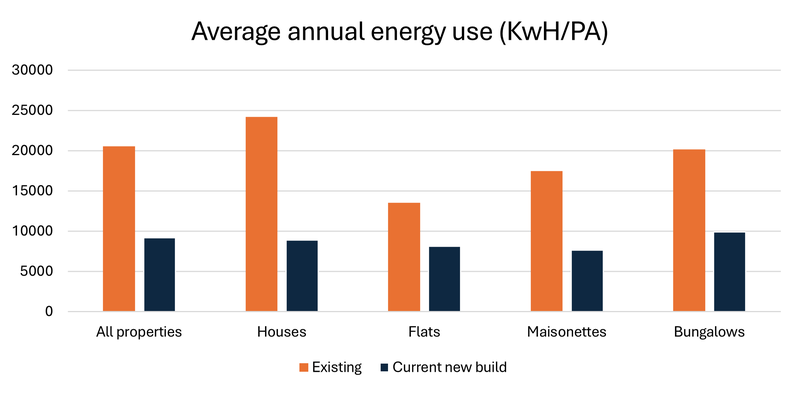Tue 05 December, 2023
Introduction
In this Parliamentary Newsletter we update you on work to progress the many ongoing and new challenges affecting the home building industry, including new research and reports from the Home Builders Federation (HBF).
We hope you find it a useful update on the home building industry’s activities and priorities but if you have any questions or would like to discuss an issue in more detail, please get in touch:
- Emma Ramell, Director of External Affairs: emma.ramell@hbf.co.uk
- Laura Markus, Policy and External Affairs Manager: laura.markus@hbf.co.uk
- Laurence Thompson, Policy and Campaigns Assistant: laurence.thompson@hbf.co.uk
About HBF
The Home Builders Federation (HBF) is the representative body of the home building industry in England and Wales. Our members are responsible for providing around 80% of all new private homes built in England and Wales and the membership are mostly small or medium-sized enterprises.
Homes in England are less affordable and in worse condition than those in most other developed nations, HBF report finds
A new HBF report has revealed the full extent of the difficulties facing people in Britain trying to find somewhere to live that is decent and affordable - with the UK falling far behind other countries on housing affordability, condition and age.
Using data collated from the OECD, the European Union, and the UK Government, the ‘Housing Horizons’ report finds that:
- England’s severe shortage of housing has made it the most difficult place in the developed world to find a home, with the lowest rate of available properties per member of the population of all OECD nations (see chart).
- Skyrocketing housing costs mean 11.3 million people in England spend more than 40% of their household income on their home - the second largest number in Europe.
- England has the highest proportion of inadequate housing in Europe, with 15% of all existing homes not meeting the Decent Homes Standard and England having more substandard homes than Hungary, Poland and Lithuania.
- The UK has some of the oldest housing stock in the developed world with only 7% of British homes built after 2001. This is far less than other countries like Spain (18.5%) and Portugal (16%).

The report comes as England remains a long way off delivering the Government’s target of 300,000 new homes per year by the mid-2020s, with only 233,000 new homes completed in 2021-22 and delivery in the first half of 2023 down by 10%.
The analysis shows that record-breaking house building of 320,000 homes per year – nearly 100,000 more than current delivery – would be required for England to provide homes for its population in line with the benchmark for developed nations worldwide, the OECD.
Stewart Baseley, Executive Chairman of the Home Builders Federation, said:
“It is widely acknowledged that Britain’s housing is in crisis, but this research shows just how badly we are falling behind our international peers.
“Decades of housing undersupply has produced startling consequences for people up and down the country looking for a decent home.
“Home builders want to be able to deliver new, high quality, energy efficient homes which will help solve our country’s housing crisis, and they expanded investment over the past decade. Sadly, developers are still too often hampered by a restrictive planning system, an anti-development mindset and short-term politics trumping the needs of communities.”
View HBF’s ‘Housing Horizons: Examining UK Housing Stock in an International Context’ report.
Firmer Foundations report: HBF sets out 10 practical policies to alleviate the housing crisis
In light of the findings outlined in our ‘Housing Horizons’ report, HBF has set out 10 practical asks for the Government which can help increase the supply of high quality new homes. The proposals can all be implemented at speed without major legislation, providing quick ways to tackle chronic housing unaffordability and poor living conditions.
HBF’s 10 policy proposals for Government are set out in the ‘Firmer Foundations’ action plan, and draw on input from our home builder membership base:
Housing supply:
- Use the increase in planning fees to sufficiently resource planning departments.
- Require local authorities to have up-to-date local plans that meet local housing need.
- Work with industry to revise rules around nutrient neutrality.
Opportunities and skills:
- Take action to make the Construction Industry Training Board (CITB) fit for purpose.
- Focus post-16 education on employers’ needs.
Market diversification:
- Introduce a presumption in favour of development on small sites to support SME home builders.
Ensuring the housing market works for all:
- Reform the Standard Method so that new housing is delivered in a proportionate way across the whole country.
- Strengthen the statutory duty on local planning decision makers to accord special attention to the need to plan for housing for older people.
Sustainable new homes:
- Abolish stamp duty for all purchases of homes with an EPC rating of B or above.
- Facilitate a roundtable between Government, industry and lenders to explore the possible expansion of green and energy efficient mortgages.
These practical policies will help get Britain building again and start to alleviate the acute housing crisis this country is facing. We at the Home Builders Federation would be happy to work with politicians of all colours on these plans, ensuring more people can find the decent homes they deserve.
Read more detail on HBF’s policy proposals.
HBF survey: British public believe building more homes is vital to resolving the housing crisis
New survey research published by HBF reveals that 68% of people believe that building more homes is vital to resolve the country’s housing crisis, and a staggering 72% place responsibility for solving the country’s shortage of homes firmly at the door of politicians.
The ‘Housing the Nation’ report, released in September, also shows that fewer than 1 in 5 think politicians truly understand the challenges facing young people trying to get on the property ladder, despite most believing that the Government is responsible for fixing the housing crisis.
The findings of the report were established through a GB-wide survey of almost 2,000 respondents carried out in April. The research also shows that:
- Support for building homes is higher than those opposing development in every region. Even in the South East, where home building is portrayed as attracting the strongest opposition from local residents, 70% of respondents were either supportive or not averse to more homes being built in their local area.
- Overall, 80% of respondents were supportive or not averse to more homes being built in their local area.
- 78% of respondents agree there is a housing crisis in the UK.
- Only 28% disagreed that housing will be an important factor in determining who they vote for at the next General Election.

The findings come as rates of home ownership among younger generations are lower than for their predecessors, and housing supply numbers continue to plummet. HBF is warning that without government intervention the current anti-business, anti-growth policy environment, coupled with a challenging economic landscape, could see housing supply halve to new record lows.
View HBF’s ‘Housing the Nation’ report.
Housing delivery levels in England stagnate in 2022-23
The Department for Levelling Up, Housing and Communities (DLUHC) has released the latest housing supply statistics for 2022-23. The statistics show that annual housing supply in England amounted to 234,400 net additional dwellings in the year to March 2023, down 70 dwellings (-0%) on 2021-22.
While the figures are broadly unchanged from last year, net additions are still 6% below their 2019-20 peak of 248,600.

In the year to March 2023, there were 239,870 gross completions. This included:
- 212,570 new build homes
- 22,160 gains from change of use from non-domestic to residential
- 4,500 from conversions between houses and flats
- 640 other gains (such as caravans and house boats).
These were offset by 5,470 demolitions.
New build completions have remained relatively high, rising 0.4% from last year to 212,570. The highest number of new build completions in 2022-23 was in the South East, at 38,200 – a rise of 2.5% from last year. New build completions in London fell by 8% from 2021-22, to 30,800.
Some leading indicators of housing supply suggest that these figures will decline in the year ahead. For instance, in the 12 months to September 2023, the number of Energy Performance Certificates (EPCs) lodged for new build dwellings decreased by 4% on the previous year. This followed a 10.7% fall during the first half of the year as compared to the same period in 2022. EPC numbers largely mirror the net additions numbers but are published more regularly, so are more up to date.
Following the release of the net supply figures, HBF said:
"After a decade of increases that saw supply double, we're now in reverse with a relentlessly negative policy agenda. While these numbers report on completions up to March 2023, all leading indicators show rapid slides in future output.
Weakening the requirements of councils to plan for the homes communities need, and a lack of local authority capacity to process applications, has seen investment in new sites collapse. A lack of support for buyers is also driving down delivery. Amidst an acute housing crisis, falling house building levels has significant social and economic consequences for the country."
The industry has also continued to make an important contribution to the delivery of new affordable homes, which are often funded via Section 106 contributions from the home building industry.
The latest DLUHC figures show:
- 30,103 affordable homes were delivered through section 106 agreements in England in 2022-23.
- Overall, almost 140,000 new affordable homes have been delivered in the past five years as a result of private sector cross-subsidy.
- Section 106 agreements funded 47% of all affordable homes delivered in England in 2022-23, up from 44% in the previous year.
Number of sites gaining planning permission down 20% to record low, Housing Pipeline report shows
HBF’s latest ‘Housing Pipeline’ report shows that the downward trend in planning permission approvals seen over the last two years continued into the second quarter of 2023, falling to record lows.
At 2,456, the number of sites granted planning permission during Q2 of 2023 was the lowest since the Housing Pipeline Report began recording in 2006. This number is 10% lower than the previous quarter, and 20% lower than the same quarter a year ago.
Meanwhile, approval was granted for 62,681 homes during the second quarter of 2023, dropping 16% from the previous quarter and 13% compared to the same period a year ago. Other than the quarter most affected by Covid-19, Q2 2020, this was the fewest permissioned homes in a quarter since 2015.
Number of housing units and projects approved, 2006-2023

Planning permissions are a lead indicator of future supply levels and if these figures translate directly to completions, it will lead to a reduction in housing delivery of 44,000 homes per year - which would see Net Housing Supply for England fall to levels not seen for a decade.
The report also provides evidence of a far reduced appetite for investment among house builders amidst a riskier planning environment, unfavourable political actions from ministers and wider economic circumstances.
View HBF’s latest Housing Pipeline report.
HBF response: Autumn Statement
HBF provided a submission to HM Treasury ahead of the Autumn Statement which took place on 22 November. The submission outlined a series of policy interventions that we believe would help increase housing delivery, in line with the asks set out in our ‘Firmer Foundations’ report.
In response to the announcements made in the Autumn Statement, HBF issued the following comments:
“Following on from the Kings Speech, the Autumn statement is another missed opportunity to address falling housing supply with policy interventions. There was no support for buyers, no meaningful measures to address the failing planning system, and no real plan to build more homes.”
In the Statement, the Chancellor announced £110 million in funding for the Local Nutrient Mitigation Fund. This funding is intended to support Local Planning Authorities (LPAs) affected by nutrient neutrality rules to deliver local nutrient offsetting schemes. It is estimated by DLUHC that such schemes could unlock 40,000 homes over the next five years. In response, HBF said:
“The money for mitigation schemes is welcome, but after four years of failure to deliver a solution it is only a partial fix. There are 150,000 homes on hold, and so a solution to unblock 40,000 over the coming years (via still to be finalised schemes) is only a sticking plaster on a gaping wound.”
The Government is also making £32 million available to tackle planning backlogs in Local Planning Authorities (LPAs) and will provide additional funding to accelerate the delivery of new housing in Cambridge, Leeds and London. HBF said:
“Whilst we welcome the recognition of the chronic underfunding of planning departments that is causing so many delays, it is estimated that we need £500m over the next 4 years to address the lack of capacity.”
New research shows residents of new homes produce under 1% of nutrient levels in rivers – yet 150,000 new homes remain blocked by ‘nutrient neutrality’ measures
New research published by Brookbanks and the Home Builders Federation starkly illustrates the minimal contribution made by residents of new homes towards nutrient levels in rivers, highlighting the disproportionate impact of Natural England’s ban on new build housing across swathes of the country.
Natural England requires that ‘nutrient neutrality’ must be demonstrated by home builders in certain river catchment areas before construction of new homes can begin. 150,000 new homes currently remain on hold due to this requirement - despite the country’s deepening and acute housing crisis - and new investment in housing delivery is plummeting.
The new research shows that the occupancy of new homes accounts for just 0.29% of total nitrogen emissions each year and 0.73% of total phosphorus (nitrogen and phosphorus make up ‘nutrients’). The research also shows that agricultural activity is responsible for around 70% of the nitrogen that finds its ways into rivers and streams.
The calculation is based on an assessment of the nutrients generated by the occupants of all new homes built in a year, assuming an average of 230,000 new homes are built each year - the average for the last three years.
The minimal contribution of occupants of new housing to nutrient pollution, demonstrated by the research, underlines the disproportionate effect of Natural England’s advice, which has resulted in a moratorium on new house building across 74 Local Authority areas.
It is estimated that the nutrient neutrality requirements could lead to a further fall in supply of 37,000 to 41,000 homes a year, despite the fact that water efficient new homes can actually help to reduce the amount of waste water occupants moving from older homes would generate.
Stewart Baseley, Executive Chairman of HBF said: “The research highlights the absurdity and pointlessness of the ongoing ban on new homes. Everyone accepts that new build housing is a negligible contributor to the issue yet after over four years the ban goes on.
"Preventing new development does absolutely nothing to improve the disgraceful quality of our rivers, but is exacerbating our acute housing crisis, preventing people accessing decent accommodation and costing jobs.
"After another missed opportunity in the King’s Speech, we urgently need to see politicians delivering a solution to address this damaging ban so that desperately needed homes can be built.”
View the Brookbanks and HBF report on nutrient pollution.
New research reveals house builders have given water companies £1bn in 3 years to upgrade infrastructure
Research by HBF shows that in the past three years, developers have given water companies more than one billion pounds in cash contributions and new assets to support upgrades to water provision and wastewater treatment.
The research demonstrates that, despite contributing very little to the problem of riverways pollution, home builders have made significant monetary contributions to water companies to ensure infrastructure is in place to facilitate the 150,000 new homes blocked by Natural England’s nutrient neutrality requirements.
The total value of contributions made by developers to water companies between 2020/21 and 2022/23 is estimated at £1.05bn, which includes:
- £427m in developer payments for Infrastructure Charges and connection fees; and
- More than £600m in new assets being added to water company balance sheets in the form of new pipes and other infrastructure from which water companies will ultimately also derive a long-term income stream from
Defra has said that ‘agriculture and wastewater are together the biggest sources of nutrient pollution in the water environment’, with a large proportion of phosphorus entering rivers resulting from a failure of water companies to effectively treat wastewater rather than from the occupants of new homes. However, despite the significant sums of money given to water companies by developers to upgrade infrastructure and unlock new homes, water companies have palpably failed to deliver.
Furthermore, water companies covering some of the areas most severely affected by the nutrient neutrality restrictions are among those to have received the highest payments from developers over recent years with Severn Trent receiving almost £70m in payments and Anglian Water topping £60m in contributions from builders.
Stewart Baseley, Executive Chairman of HBF said: “Despite the fact that new homes make a negligible contribution to the nutrients issue, around 145,000 homes across the country remain on hold. Whilst doing nothing to reduce the disgraceful pollution of our rivers the ban is deepening our housing crisis, reducing economic activity and costing jobs. After four years we need to see politicians delivering a solution to address this damaging ban so desperately needed homes can be built.”
Read more detail about HBF’s research into developer contributions to water companies.
£2.8 billion in developer contributions is held unspent by local authorities, HBF research finds
HBF research estimates that a total of £2.8 billion in home builder contributions used to fund local services and infrastructure upgrades could be sat unspent in local authority bank accounts.
The ‘Section 106 Agreements and Unspent Developer Contributions’ report is based on Freedom of Information (FOI) responses from 171 local authorities, constituting 50% of all local authorities in England and Wales. It shows that an average of £8 million in developer contributions is held unspent by each council. Extrapolating these findings across all local councils suggests that almost £2.8bn in contributions from builders, which could be used to fund local infrastructure, remains in bank accounts.
This figure includes:
- £567m allocated for affordable housing, enough to fund the construction of nearly 7,000 desperately needed ‘social’ homes
- £420m held in unspent education contributions could cover training costs of 45,000 teachers
- £384m of unspent highways contributions, enough to repair over 6 million potholes
- £334m in unspent social infrastructure contributions would pay for 1,900 community games areas
Home builders make ‘Section 106’ contributions to local authorities as part of the process of securing planning permission. The purpose of the funding is to invest in community services, facilities and affordable housing to ensure local people benefit from development within their area.
This research suggests that a lack of capacity or unwillingness to spend these developer contributions is preventing communities from realising the benefits of local investment. This has inevitable consequences for locals’ perceptions of new homes, further fuelling resurgent NIMBYism that threatens development across England and Wales.
HBF is calling for developers’ contributions to be spent according to their negotiated purpose and within their agreed time limit, rather than returned to developers or left unspent.
Stewart Baseley, Executive Chairman at HBF, said: “Each year developers contribute around £8 billion to local authorities for the provision of local infrastructure, affordable housing and education, recreational and health facilities.
“Investment in new housing delivery brings unrivalled economic and social benefits to communities but too many of these advantages are going unseen by local people as councils fail to turn payments into the services, facilities and infrastructure that residents want. Not only is this a disservice to communities but it undermines perceptions of home building, allowing lazy negative perceptions to persist.
“In the face of a deepening housing shortage and cost of living crisis, it has never been more important to build new homes and local people should enjoy the benefits that can bring.”
View the ‘Section 106 Agreements and Unspent Developer Contributions in England and Wales’ report.
Save the date: Skills parliamentary reception, 12 March
HBF will be hosting a ‘drop in’ Skills Parliamentary reception on 12 March. The reception will provide an opportunity for MPs and Peers to come and meet apprentices, graduates, trainees, career ambassadors and other new entrants from across the home building industry.
The event will be held in the Terrace Pavilion, House of Commons, on the afternoon of Tuesday 12 March 2024. Please get in touch with Laura Markus at laura.markus@hbf.co.uk for more details.
